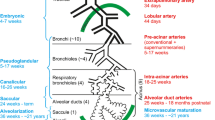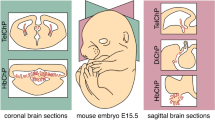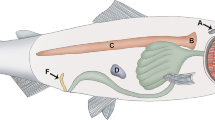Objectives. To study the morphometric parameters and ciliary activity of ciliated ependymocytes during the postnatal development of the cerebral ventricles. Materials and methods. Digital in vivo videomicroscopy, histological methods, and morphometry were used to study the vascular plexuses and the structural and functional characteristics of ciliated ependymocytes in biopsies of the walls of the cerebral ventricles from 109 Wistar rats during the first year of life. Results. Morphofunctional transformations of the vascular plexus and ciliated ependymocytes the cerebral ventricles of the rat brain were more marked in the first 20 days after birth. These included accelerated increases in the size of the vascular plexus, maximal values for morphometric parameters of ciliated ependymocytes and measures of their ciliary activity, and maximum rates of movement of the CSF in the wall layer as compared with animals of reproductive age. By 4–12 months, measures of ciliary clearance decreased to 30–50% of maximal in all ventricles. Conclusions. During the first 20 days of postnatal ontogeny, the cerebral ventricles in rats showed significant changes in the morphometric and functional parameters of ciliated ependymocytes, whose activity is believed to provide the mechanism producing movement of the CSF. A more efficient mechanism for CSF circulation appears by later time points in the development of the vascular plexus, so the role of the transport function of ependymocytes decreased.
Similar content being viewed by others
References
I. P. Zapadnyuk, V. I. Zapadnyuk, and E. A. Zakhariya, Laboratory Animals. Breeding, Keeping, and Use in Experiments, Vishcha Shkola, Kiev (1974).
D. É. Korzhevskii, “The vascular plexus of the brain and the structural organization of the blood-CSF barrier in humans,” Regionarn. Krovoobr. Mikrotsirk., 2, No. 1 (7), 5–14 (2003).
A. E. Korshunov, “Physiology of the CSF system and the pathophysiology of hydrocephalus,” Vopr. Neirokhirurg. im. Burdenko, No. 4, 45–50 (2010).
A. V. Pavlov and O. A. Fokanova, “Structural and functional characteristics of the ependyma of the cerebral ventricles in rats during the first month of life,” Morfologiya, 151, No. 3, 94 (2017).
A. V. Pavlov, T. V. Korableva, L. I. Esev, et al., “Methodological approaches to experimental studies of the histophysiology of the mucociliary transport system of the fallopian tubes,” Morfologiya, 155, No. 1, 60–65 (2019).
L. G. Sentyurova and D. L. Teplyi, “Morphogenesis of the vascular plexus of the brain in vertebrate animals and humans,” Estestv. Nauki. Eksperim. Fiziol. Morf. Med., 45, No. 4, 82–87 (2013).
B. Banizs, M. M. Pike, C. L. Millican, et al., “Dysfunctional cilia lead to altered ependyma and choroid plexus function, and result in the formation of hydrocephalus,” Development, 132, No. 23, 5329–5239 (2005).
M. R. Del Bigio, “Ependymal cells: biology and pathology,” Acta Neuropathol., 119, No. 1, 55–73 (2010), doi: https://doi.org/10.1007/s00401-009-0624-y.
V. Korzh, “Development of brain ventricular system,” Cell. Mol. Life Sci., 75, No. 3, 375–383 (2018), doi: https://doi.org/10.1007/s00018017-2605-y.
S. A. Liddelow, K. M. Dziegielewska, J. L. Vandeberg, and N. R. Saunders, “Development of the lateral ventricular choroid plexus in a marsupial, Monodelphis domestica,” Cerebrospinal Fluid Res., 7, 16 (2010), doi: https://doi.org/10.1186/1743-8454-7-16.
M. P. Lun, E. S. Monuki, and M. K. Lehtinen, “Development and functions of the choroid plexus-cerebrospinal fluid system,” Nat. Rev. Neurosci., 16, No. 8, 445–457 (2015), doi: https://doi.org/10.1038/nrn3921.
E. W. Olstad, C. Ringers, J. N. Hansen, et al., “Ciliary beating compartmentalizes cerebrospinal fluid flow in the brain and regulates ventricular development,” Curr. Biol., 29, No. 2, 229–241 (2019), doi: https://doi.org/10.1016/j.cub.2018.11.059.
Z. B. Redzic, J. E. Preston, J. A. Duncan, et al., “The choroid plexus-cerebrospinal fluid system: from development to aging,” Curr. Top. Dev. Biol., 71, 1–52 (2005).
B. Siyahhan, V. Knobloch, D. Zélicourt, et al., “Flow induced by ependymal cilia dominates near-wall cerebrospinal fluid dynamics in the lateral ventricles,” J. R. Soc. Interface, 11, No. 94, 1098–1189 (2014).
Z. Soygüder, H. Karadağ, and M. Nazli, “Neuronal nitric oxide synthase immunoreactivity in ependymal cells during early postnatal development,” J. Chem. Neuroanat., 27, No. 1, 3–6 (2004).
K. L. Todd, T. Brighton, E. S. Norton, et al., “Ventricular and periventricular anomalies in the aging and cognitively impaired brain,” Front. Aging Neurosci., 9, 445 (2018), doi: https://doi.org/10.3389/fnagi.2017.00445.
D. Vidovic, R. A. Davila, R. M. Gronostajski, et al., “Transcriptional regulation of ependymal cell maturation within the postnatal brain,” Neural Dev., 13, No. 1, 2 (2018), doi: https://doi.org/10.1186/s13064-018-0099-4.
Author information
Authors and Affiliations
Corresponding author
Additional information
Translated from Morfologiya, Vol. 156, No. 5, pp. 9–16, September–October, 2019.
Rights and permissions
About this article
Cite this article
Pavlov, A.V., Fokanova, O.A. & Korableva, T.V. Morphofunctional Transformation of Ependymocytes during the Postnatal Development of the Cerebral Ventricles in Rats. Neurosci Behav Physi 50, 639–644 (2020). https://doi.org/10.1007/s11055-020-00946-7
Received:
Published:
Issue Date:
DOI: https://doi.org/10.1007/s11055-020-00946-7




